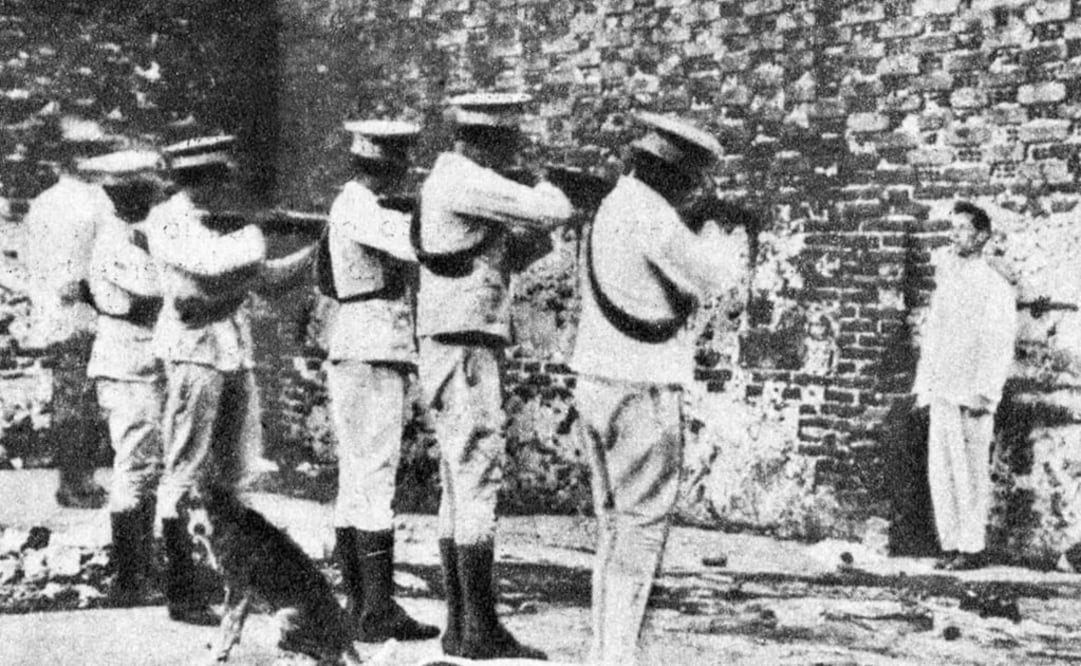Since pre-Columbian times , in Mexico , there were several punishments established by certain leaders depending on the crime that varied from stoning to hand mutilation to even death .
If an act was considered a crime for the people in charge of the pre-Columbian law, the compensation could be “expensive:” The Aztecs and Tlaxcaltecs killed, through pressure with two rocks , those who committed adultery , fornication , or who were alcoholics ; if two same-sex persons were found in having sexual intercourse, they could be killed using a club . The thieves who were caught stealing had one of their hands cut.
After the pre-Columbian era, and although the issue had been addressed in the political and legal arenas, during Colonial times , ecclesiastical authorities were in charge of implementing harsh punishments to those who were accused of heresy or other offenses considered serious in that time. Many of those “punishments” were ordered by the Holy Inquisition and caused death in the end.
In the legal environment , a brief recount on this matter reveals how not even the Cádiz (1812), nor the Apatzingán (1814) constitutions mentioned the death penalty , defined as the maximum correction that consists in taking life away.
In the 1824 and 1842 constitutions , there was the first direct antecedent . Hence, in the latter, there was a particular vote of the minority of the Constituent Commission , which banned its application for political crimes but not for road thieves , arsonists , parricides , and homicides with malice or intent.
For 1857 , the Magna Carta had eliminated the death penalty for all crimes and in article 77 mentioned that “The capital punishment in the State will not be implemented for any crime subject to its competence.”
Nevertheless, in 1929 , the death penalty appeared once again in the Constitution (under certain circumstances). Despite it, this sanction was abolished in the Penal Code and hence it was excluded in the federal environment, in the federal territories, and in Mexico City. “Then, it was canceled from the punishments in state penal codes ,” according to the text “ Death Penalty in Mexico ” by the researcher Olga Islas de González Mariscal from the Legal Research Institute .
Since each entity is independent, as well as its Penal Code and its legislative power, they could abolish this punishment in every state: “each entity has a Congress of its own and they are the ones in charge of approving or modifying the existing laws according to their faculty,” mentions the researcher and expert of the Legal Research Institute of the National Autonomous University of Mexico Diana Gutiérrez .
This does not mean that the Penal Code is over the Constitution but rather that, according to lawyer Alfonso Ochoa , “it was first in the penal code and not in the Constitution because it originated from a concern in the states. Since it was not explicitly prohibited in the Constitution, they could put it first locally and then federally.”
Regarding the late introduction, the expert said that “it took so long [in disappearing from the 1917 Magna Carta] because there was no pressure from other countries on Human Rights , which changed with the wave of them at an international scale .”
In the 1917 Magna Carta , article 22 , stanza IV had some extra crimes such as the one of traitor to the motherland in foreign wars, pirates , and convicts in the case of serious offenses of military matters , even to those who stole livestock .

In addition, the changes to the Constitution imply a longer process so, in 2002 , mentions the expert Olga Islas , “the First Penal Code for the Federal District , coherent with this legal evolution, didn’t include this discussed punishment.” Hence, the death penalty was banned in the Magna Carta until 2005 .
Some famous people who were shot
According to the website Memoria política de México , some of the most famous characters of the 19th century that died from the death penalty were: heroes from the Mexican Independence such as Miguel Hidalgo y Costilla , in Chihuahua in 1811 for high treason and for being “leader of malicious homicides.”
Also in Chihuahua in 1811, Ignacio Allende , Juan Aldama , and Mariano Jiménez died for treason, while in Ecapatec in 18151, J osé María Morelos y Pavón did so for heressy and treason.
Agustín De Iturbide
was shot in Tamaulipas in 1824 under the crimes of treason to the motherland and was also declared a public enemy of the State.
In 1831, Vicente Guerrero lost his life for offenses like conspiracy and rebellion among others.
In 1867, Emperor Maximiliano of Habsburg, along with his generals Tomás Mejía and Miguel Miramón , were killed in Querétaro with the instauration of the Republic with Benito Juárez. The crimes for which they were shot were against the nation, such as order, public peace, and individual warrants alteration.
While in the 20th century we find cases such as the ones of José de Jesús Negrete , a.k.a. “ The Santa Julia Tiger ,” in the Belem prison in 1910 for homicide, theft, and rebellion against the State. In the 1920s, Priest Miguel Agustín Pro de Juárez was killed for infringing upon general Álvaro Obregón. In 1929, José de León Toral was killed in the Lecumberri prison for the homicide of the general and President-elect Álvaro Obregón.
The case of Priest Miguel Agustín Pro: An innocent
An emblematic case was that of priest Miguel Agustín Pro Juárez in the 1920s during the so-called Cristero War . Without being guilty of an attack against general Álvaro Obregón, which was actually committed by one of his brothers, the priest was shot “for justice,” during the Plutarco Elías Calles administration.

Without enough evidence, authorities said the three Pro Juárez brothers (Humberto, Roberto, and Miguel), among other persons, were the suspects and were arrest on November 17, 1927 , five days after the attack.
A night before his death, a friend of Miguel Agustín Pro, without knowing the sad news, asked what he would do if he were to be shot by the government, the priest answered “ I would ask them to let me kneel, some time to male an act of contrition and die with my arms making a cross screaming ‘Long live Jesus Christ!’ ” which was a characteristic of the “Catholic exercise” in those times.


On November 23 , in front of the generals Roberto Cruz, Antonio Gómez Velasco, journalists, and photographers, Luis Segura, Juan Tirado, Miguel Agustín and Humberto Pro were shot. The priest “gave away his life” was he had told a night before. The place where he died is now occupied by the National Lottery building .
The last executions in Mexico
In Mexico, according to the articles published in this newspaper , the last executions took place in Saltillo , Coahuila in 1961 . The man who was sentenced was “a soldier called José Isaías Constante Laureano , who committed insubordination and killed two of his superiors.”
However, the most famous executions of the time were those that took place in Hermosillo , Sonora on June 17, 1957 . The sentenced were two men accused of homicide and rape . They were Francisco Ruíz Corrales , a 27-year-old laborer, and José Rosario Don Juan Zamarripa , a former 40-year-old soldier.
The first, raped and strangled a six-year-old girl called María de la Luz Margarita Mendoza Noriega , who was known in the community for selling tomatoes. Ruíz Corrales told the girl that he would buy all her merchandise in exchange for her going with him to his house, but he took her to an isolated area and committed the terrible crimes.
The latter committed the same crimes but with a four-year-old girl called Ernestina Leyva in 1950 and threw the body of the girl to the Yaqui river. Although the version of the official chronicler of Hermosillo, Gilberto Escobosa Gámez, said it was a three-month-old girl, whom Don Juan Zamarripa had stolen from her crate, as he told EL UNIVERSAL in 2003.
The then-governor Álvaro Obregón Tapia “ordered the convicts to be put in hands of the corresponding authorities to be shot,” according to an article published by EL UNIVERSAL on June 18, 1957 .


“Zamarripa was blindfolded; Corrales said no, that he didn’t need it, he kept asking for pardon for having served in the Revolution,” according to Alberto Ríos Bermúdez , the executing judge of the last two death penalties in Sonora, who was interviewed by Miguel Ángel Avilés , author of the book Three Ways to Die… And The Same Story .
Ríos Bermúdez added that “It was not the rape offense that caused the death penalty but the homicide of the girls; however, it was applied to prevent this kind of sex crimes to continue, but they have gone on until our days.” The judge mentioned that for the event, all convicts were put in a cell where the could watch the execution as a demonstration of their possible future.
Before dying, the priest Roberto Montaño went to the State jail to confess the criminals and give them peace in their last minutes: Ruíz Corrales accepted for Zamarripa did not.
Alberto Ríos Bermúdez
mentioned that the spectators (distinguished officials, police officers, and bystanders) began to arrive since the early morning.
The rapists did not immediately die after being shot but the squad leader administered the coup de grace . This execution was attended by officials related to the legal procedure and the EL UNIVERSAL correspondent Jorge Orozco y Girón said that local journalists were also allowed to partake in.
The disappearance of the death penalty from legal statutes was gradual. The states of the Republic abolished it in the following order Michoacán (1924), Querétaro (1931), Jalisco (1933), Zacatecas (1936), Chihuahua (1937), Chiapas and Yucatán (1938), Sinaloa (1939), Coahuila (1941), Campeche and Puebla (1943), Durango (1944), Veracruz (1945), Aguascalientes (1946), Guerrero (1953), Colima, Guanajuato, and Nayarit (1955), Tamaulipas (1956), Tlaxcala (1957), the State of México and Tabasco (1961), Hidalgo (1962), San Luis Potosí and Nuevo León (1968), Morelos (1970), Oaxaca (1971), and Sonora (1975).
Nevertheless, it was until September 9, 2005 , when the government of President Vicente Fox abolished the Death Penalty and any kind of torture in Mexico during the presentation of his First Report of Execution of the National Human Rights Program . That occasion, the words of the President were; “This day will remain in the national memory like that in which Mexico joined the countries that have one of its highest rights that of the respect to life.”
Nowadays, and according to the official website of Amnesty International , since 1977 , this organization has developed the labor of abolishing this penalty and until now, 104 countries have banned it, including Mexico.

However, there are still several nations that keep implementing it within their law through beheading , electrocution , hanging , lethal injection , execution by firing squad , and stoning , among others.
It is highly probable that uncountable innocent people have died under the death penalty all around the world. Hence the controversy of this punishment has always been alive internationally. Organisms such as Amnesty International consider that with it, there is the risk of condemning people who are not guilty since it can be performed within unfair legal systems , and applied in a discriminatory way, and even as a political tool, and that in countries such as the United States, despite its use, crime has not stopped.
mp
Noticias según tus intereses
[Publicidad]
[Publicidad]














